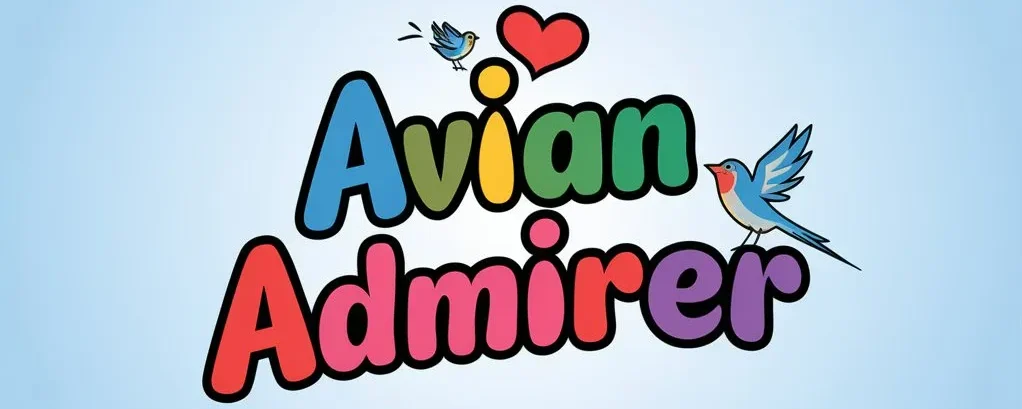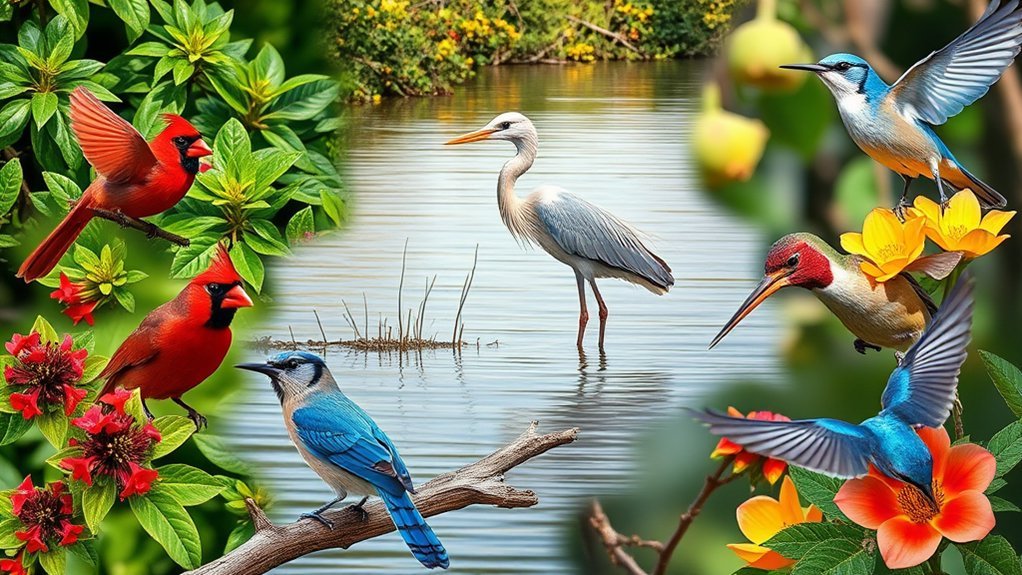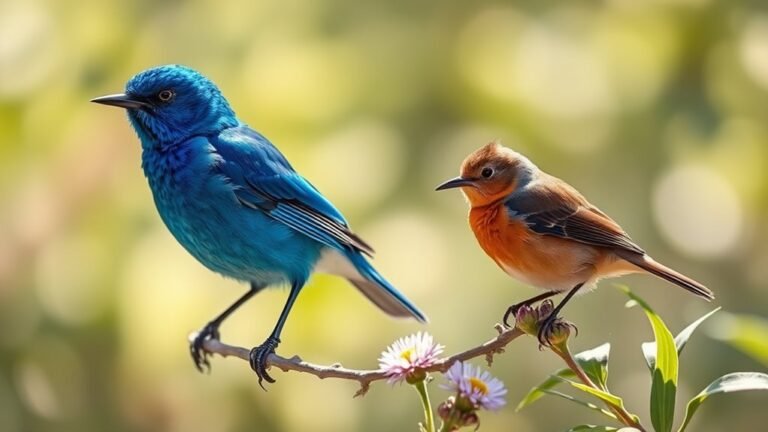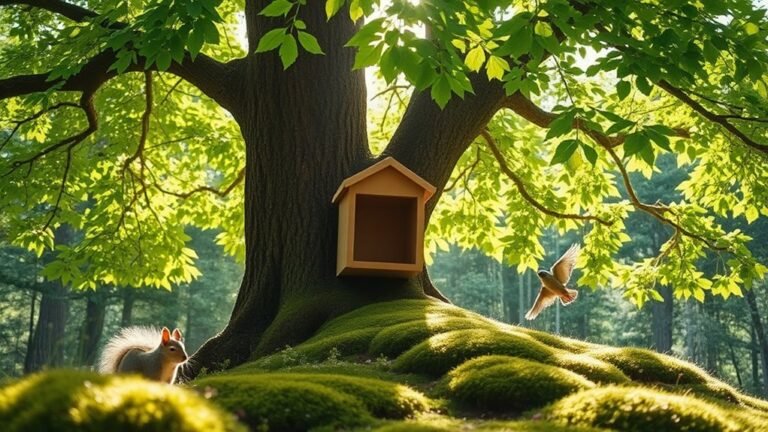Bird Identification South Carolina: Recognizing Local Species
In South Carolina, identifying birds can help you appreciate the diverse wildlife in the area. The state has many habitats where you can see coastal, forest, and backyard species. To improve your ability to identify birds, focus on their unique physical traits, behaviors, and songs. Using the right tools and resources can enhance your experience. Understanding these aspects will allow you to discover more about the birds in South Carolina. Enjoy the process of learning and observing the various species found in this beautiful region.
Key Takeaways
Bird Identification in South Carolina
- Learn about common birds like the Pileated Woodpecker and Black Skimmer that live in South Carolina's diverse habitats.
- Use binoculars with 8x to 10x magnification for clear and detailed views of birds.
- Refer to field guides tailored to South Carolina to help you identify local species and their specific traits.
- Observe birds' physical features, behaviors, and songs to help distinguish between different species while birdwatching.
- Join local birding clubs or guided tours for practical experiences and advice from experts on identifying birds in the area.
Enjoy the simple pleasure of birdwatching and explore the fascinating birds that South Carolina has to offer!
Overview of South Carolina's Birdwatching Opportunities
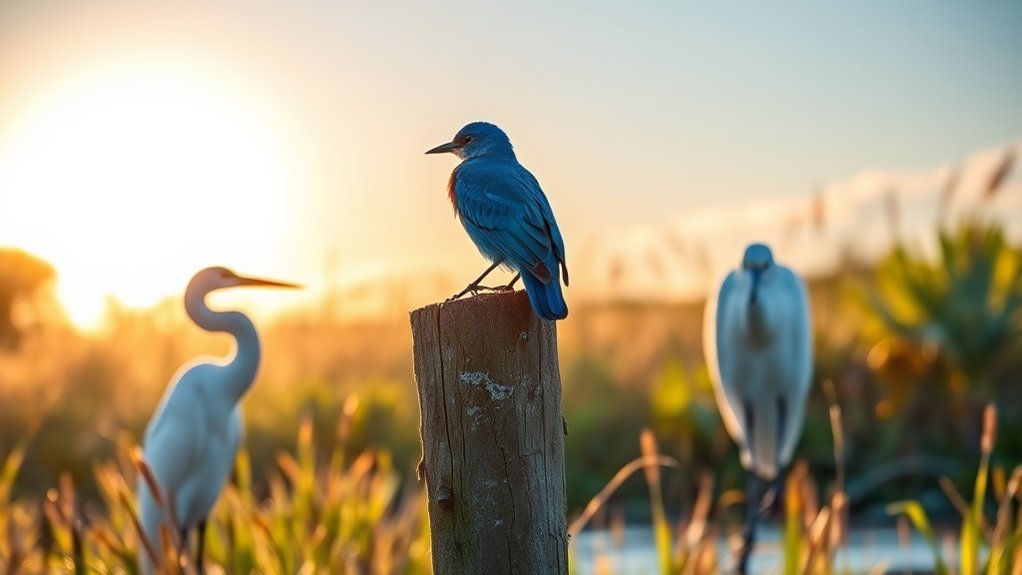
Birdwatching in South Carolina offers enthusiasts a variety of habitats that attract many bird species. Some top birdwatching locations include the ACE Basin and Francis Marion National Forest. These areas provide ideal settings for both migratory and resident birds.
Visitors can participate in local birding festivals, allowing them to meet other bird lovers and expand their knowledge. Events like the South Carolina Birding and Wildlife Festival showcase the state's beauty and wildlife diversity.
Whether you're a seasoned birder or a beginner, these experiences help you connect with nature and the birding community. Discover South Carolina's unique birds and enjoy these exciting opportunities.
Essential Tools for Bird Identification
To improve your birdwatching experience in South Carolina, use the right tools for bird identification.
Start with good binoculars. Choose ones with a magnification of 8x to 10x and a large objective lens for bright, clear images. Ensure the binoculars are lightweight and portable for longer outings.
Next, get a reliable field guide. This guide will help you identify different bird species and understand their behavior and calls. Choose a guide that focuses on South Carolina to ensure you have accurate information about local birds.
With quality binoculars and a helpful field guide, you'll feel more confident and connected to the beautiful birds around you.
Happy birdwatching!
Understanding Bird Habitats in South Carolina

South Carolina has many different habitats that support its diverse bird population. Coastal wetlands, forests, and other environments provide essential conditions for various bird species.
Many birds require specific places to nest and raise their young. For example, some birds nest in the safety of marshes, while others prefer the tops of trees.
Conserving these habitats is important. Protecting these environments ensures that birds have the resources they need to survive.
By recognizing and safeguarding these habitats, you help preserve South Carolina's natural heritage. This effort also encourages a sense of community among bird lovers.
Exploring and enjoying these rich habitats can deepen your appreciation for the state's wildlife.
Common Coastal Birds to Spot
The coastal areas of South Carolina are home to many bird species. You can spot the Black Skimmer and Wilson's Plover here.
These birds build their nests on the beach and select safe spots for their eggs. Watch how Skimmers perform energetic courtship displays. This behavior shows their social connections.
You can also see how they forage by gliding over the waves to catch small fish. Observing these actions will enhance your birdwatching experience. It lets you connect to the lively coastal community, where each bird contributes to the ecosystem's balance.
Notable Forest Birds of the Region
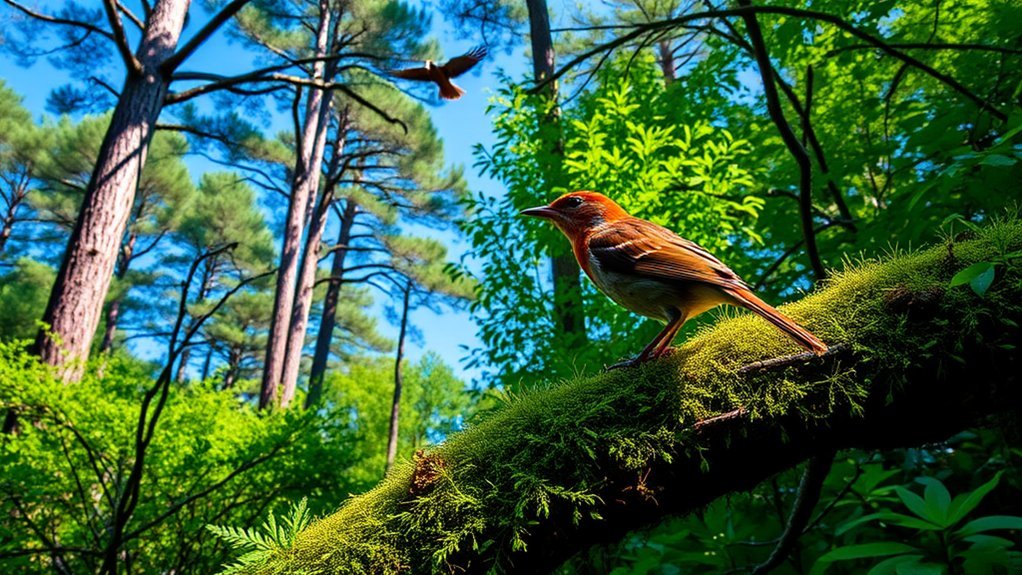
As you visit the forests of South Carolina, you'll see a variety of interesting bird species that live in these rich habitats.
Bird watching in this area can be enjoyable, with key species to look for, including:
- Pileated Woodpecker – This bird features a unique crown and creates loud drumming sounds, contributing to the forest's natural soundtrack.
- American Redstart – This small bird displays vibrant orange and black feathers as it moves quickly through the trees.
- Barred Owl – Their distinctive calls can be heard at night, indicating a healthy environment.
- Northern Parula – This colorful warbler prefers the dense treetops and highlights the need to protect these habitats.
Spotting these birds strengthens our bond with nature and reminds us of the importance of conservation efforts.
Unique Migratory Species in South Carolina
South Carolina has many migratory bird species. Every year, birdwatchers can see different migration patterns.
Some common and rare birds visit the state during migration. The magnificent frigatebird and roseate spoonbill are often seen on the coast, captivating bird lovers with their distinct looks. Changes in the seasons cause these birds to travel long distances, showing their adaptability.
Joining local birding groups can help you learn more about these migratory patterns. You can connect with other bird enthusiasts while raising awareness for conservation efforts.
Tracking these bird species also allows you to appreciate South Carolina's diverse birdlife. Take this chance to enjoy nature and meet fellow bird lovers.
Tips for Identifying Shorebirds
How can you identify shorebirds while visiting South Carolina's coast? Focus on key features and behaviors to improve your birding skills. Here are some helpful tips:
- Size and Shape: Observe the size and shape of the bird. For example, herons are larger than smaller sandpipers.
- Bill Shape: Look at the bill. Long bills usually indicate the bird probes into sand or mud for food. Short bills suggest they eat seeds or insects.
- Feeding Habits: Notice how the birds feed. Do they run on the shore or wade in the water?
- Plumage Patterns: Identify unique markings or colors. These features can help you differentiate between species.
Using these techniques will improve your ability to spot and identify shorebirds.
Enjoy your birdwatching experience!
Recognizing Common Backyard Birds
While you enjoy your backyard, you may notice many different birds visiting. Common birds like cardinals, blue jays, and sparrows often come to backyards. You can learn to identify them by looking at their colors and sizes.
To attract more birds, try putting up feeders filled with seeds. This will bring a variety of birds to your yard. Watch how they interact; some birds are bold, while others are timid.
The Importance of Bird Song in Identification
Birdsong is a key factor in identifying bird species. Each bird has its own unique song, which can help you recognize them in nature. Listening carefully to their sounds enhances your birdwatching experience.
Focus on these important elements:
- Rhythm: Listen for patterns in the melodies.
- Volume: Notice how loud or soft the calls are.
- Tone: Pay attention to the quality of the sound—whether it's sharp, mellow, or piercing.
- Context: Take into account the area where you hear the song, as this might indicate specific behaviors or territorial displays.
By focusing on these aspects, you can improve your identification skills and deepen your appreciation for South Carolina's birdlife.
Enjoy the sounds as you explore the outdoors!
Seasonal Birdwatching Trends
As the seasons change in South Carolina, birdwatching patterns also shift, providing distinct opportunities to observe various species throughout the year.
In spring, migration brings flocks back from their winter homes. This season is ideal for seeing vibrant songbirds and observing nesting behaviors in local parks and wetlands.
During summer, resident birds exhibit unique seasonal behaviors, making it a rewarding time to watch.
Autumn marks the gathering of migratory species preparing for their journey south.
Finally, winter offers a chance to spot resilient residents and occasional visitors escaping colder areas.
Understanding these seasonal trends enhances your birdwatching experience. It connects you to nature and fosters a sense of community among fellow birdwatchers.
Enjoying the sights and sounds of different birds at each season makes South Carolina's landscapes feel alive.
Resources for Bird Enthusiasts in South Carolina
If you want to improve your birdwatching experience in South Carolina, there are several helpful resources for both beginners and seasoned birders.
Here are four essential tools to support your journey:
- Birding Apps: Use apps like Merlin Bird ID or eBird to identify different bird species and keep track of your sightings.
- Local Clubs: Join a birding club in your area to meet other bird lovers and exchange tips and advice.
- Guided Tours: Take part in organized birdwatching tours to explore diverse habitats and find unique bird species.
- Field Guides: Get a good field guide focused on South Carolina birds to improve your identification skills.
These resources will help you learn more about the wonderful birds in your area and make your birdwatching experience more enjoyable.
Frequently Asked Questions
What Time of Year Is Best for Birdwatching in South Carolina?
The best time for birdwatching in South Carolina is during migration seasons. In spring and fall, many different bird species move through the area. This provides an exciting opportunity to see a variety of birds. Birdwatchers can enjoy the vibrant displays of these seasonal travelers as they pass through South Carolina on their journeys. It's an ideal time to grab your binoculars and explore the skies.
Are There Any Birdwatching Festivals in South Carolina?
Yes, South Carolina hosts several birdwatching festivals each year. These events include guided tours, educational workshops, and a chance to meet other birdwatching enthusiasts. Participants can learn about different bird species and enjoy nature activities.
How Do I Report Rare Bird Sightings in the State?
To report rare bird sightings, you should follow specific steps. First, document your observations clearly, noting the bird's appearance, location, and behavior. Next, submit this information to local birding groups or online platforms where bird enthusiasts share sightings. Accurate documentation helps others in the community learn about and protect rare birds. Your contributions are valuable to the conservation effort.
What Apps Are Useful for Bird Identification in South Carolina?
For bird identification in South Carolina, you can use mobile apps like Merlin Bird ID and eBird. These apps provide helpful tips for identifying birds. They assist you in recognizing different bird species during your observations. Using these apps can boost your confidence in birdwatching.
Where Can I Find Local Birdwatching Groups or Clubs?
You can find local birdwatching groups on websites like Meetup or the Audubon Society. Joining these groups helps you meet other birdwatching fans and share your interest. This connection can make your birdwatching outings more enjoyable and informative.

Ava is a bird enthusiast and nature lover who has spent countless hours observing and learning about the fascinating world of birds. With a passion for sharing her knowledge and inspiring others to appreciate the beauty of birds, Ava writes about her experiences and insights on avianadmirer.com.
